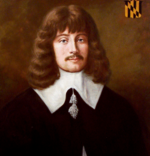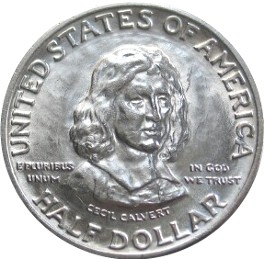Cecil Calvert, 2nd Baron Baltimore facts for kids
Quick facts for kids
The Lord Baltimore
|
|
|---|---|
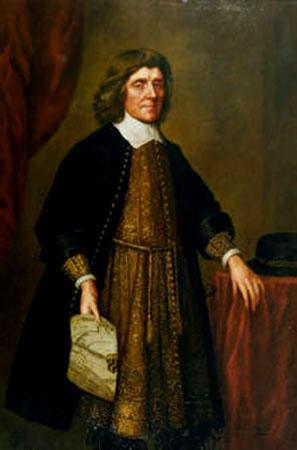
Cecil Calvert, 2nd Lord Baltimore
Retrospective painting by Florence MacKubin, 1910 |
|
| Governor of Newfoundland (Avalon) | |
| In office 1629–1632 |
|
| Monarch | Charles I |
| Proprietor of the Maryland colony | |
| In office 1632–1675 |
|
| Personal details | |
| Born | 8 August 1605 Kent, England |
| Died | 30 November 1675 (aged 70) Middlesex, England |
| Spouse | Anne Arundell |
| Children | 9, including The 3rd Baron Baltimore |
| Parents | George Calvert, 1st Baron Baltimore Anne Mynne |
| Alma mater | Trinity College, Oxford |
| Occupation | Lawyer Politician |
Cecil Calvert, 2nd Baron Baltimore (born August 8, 1605 – died November 30, 1675) was an important English nobleman. He is best known for being the first owner, or "Proprietor," of the Province of Maryland in America. He also served as the Governor of the Newfoundland Colony.
Cecil Calvert inherited the plan for Maryland from his father, George Calvert, 1st Baron Baltimore. He managed the Maryland colony from his home in England. As a Roman Catholic, he worked to create a place where people of different Christian faiths could live together peacefully. Maryland became a safe place for Catholics, especially when they faced difficulties in England. Lord Baltimore guided Maryland for 42 years.
Contents
Early Life and Education
Cecil Calvert was born on August 8, 1605, in Kent, England. His father, George Calvert, was a lawyer who worked for King James I's Secretary of State. Cecil was named "Cecilius" in honor of his father's boss. His mother was Anne Mynne. Cecil was the first of many sons. At that time, his family was part of the Church of England.
In 1621, Cecil went to Trinity College, Oxford University. His mother passed away the next year. In 1625, his father, George Calvert, became the first Baron Baltimore. Around the same time, his father became a Roman Catholic, and it's believed his children, including Cecil, followed him.
In 1628, Cecil Calvert joined his father and family on a trip to the new Newfoundland Colony. This colony didn't work out because of sickness, very cold weather, and attacks by the French. The family soon returned to England.
When his father died in April 1632, Cecil became the second Baron Baltimore. In 1633, he became a lawyer.
Starting the Maryland Colony
Maryland's Royal Charter
After his father passed away, Lord Baltimore received a special document called a "Charter" from King Charles I. This Charter allowed him to start a new colony called Maryland. The colony was named after Queen Henrietta Maria, King Charles I's wife. Cecil's father had wanted to create a colony in America where English Roman Catholics could find safety.
The King's grant of land was huge. It included the western side of the Chesapeake Bay and all of the eastern side. However, the King soon realized that settlers from Virginia were already living on the southern part of the eastern shore. So, the grant was changed. The final Charter was approved on June 20, 1632.
Lord Baltimore paid the King a small fee for the land. He had to give the King one-fifth of any gold and silver found. He also had to deliver two Native American arrows to Windsor Castle every Easter. The Charter made Maryland a "palatinate." This meant Lord Baltimore had special rights, almost like an independent ruler. He could even start wars and collect taxes! If there were any questions about his rights, the Charter said they should be decided in his favor.
People in the Virginia colony didn't like the idea of a new colony nearby. Instead of going to Maryland himself, Lord Baltimore stayed in England. He needed to protect his new Charter from people who wanted to stop the colony. He sent his younger brother, Leonard Calvert, to lead the first settlers. Cecil Calvert never actually visited Maryland.
While preparing the trip, Lord Baltimore had to defend his Charter. Some former members of the Virginia Company tried to get their old Charter back, which would have included Maryland. They argued that Maryland wasn't truly unsettled because a trader named William Claiborne already had a trading post on Kent Island. They also said the new Charter gave Lord Baltimore too much power.
Ark and Dove Ships
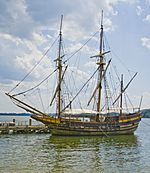
The first group of settlers sailed on two ships, the Ark and the Dove. They left Gravesend, England, with 128 settlers. The British Royal Navy stopped them and made the settlers promise loyalty to the King. Then, in October 1632, they sailed to the Isle of Wight to pick up more people. Two Jesuit priests and almost 200 more settlers joined them before they crossed the Atlantic Ocean.
Lord Baltimore gave his brother, Leonard, very clear instructions for the colony. He told him to find out about anyone trying to cause trouble. He also told him to talk to William Claiborne about his trading post on Kent Island. Most importantly, Lord Baltimore stressed that everyone in the colony must respect each other's religious beliefs. The settlers were almost equally Catholic and Protestant.
With these instructions, the ships sailed across the Atlantic. They entered the Chesapeake Bay and the James River. After meeting with the Virginians, they continued up the Bay to the Potomac River. On March 25, 1634, they landed on Blakistone Island (now St. Clement's Island). There, they put up a cross and held their first religious service. A few days later, they founded the first settlement at St. Mary's City on March 27, 1634. They bought the land from the local Yaocomico tribe.
From England, Lord Baltimore worked to manage the colony's relationships with the King and government. William Claiborne, the trader, continued to cause problems and even had some small fights with the new settlers.
Cecil Calvert stayed very involved in running the colony, even though he never visited it. He appointed others to govern for him. His younger brother, Leonard Calvert, was the first governor. His only son, Charles, was the last.
Challenges During the English Civil War
At this time, England was facing big problems. In 1629, King Charles I had stopped Parliament from meeting. He ruled alone for eleven years. Religious tensions were high, and many Puritans and Catholics faced difficulties. Because of this, many Puritans moved to New England, and Catholics began to see Maryland as a possible safe place.
Lord Baltimore, being Catholic, worked hard to keep control of Maryland during the English Civil War. He tried to show Parliament that he was loyal. He even appointed a Protestant, William Stone, as his governor. He did this to make sure he could keep his colony during the war, even though he supported the King.
Religious Tolerance in Maryland
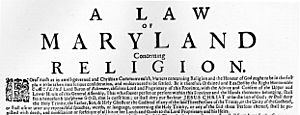
On April 21, 1649, Maryland passed a special law called the Maryland Toleration Act. This law said that all Christians who believed in the Holy Trinity (Father, Son, and Holy Spirit) should have religious freedom. It was the first law of its kind in the British colonies of North America. The Calvert family wanted this law to protect Catholic settlers and other Protestants who didn't follow the official Church of England. However, this law was later cancelled for a short time.
Baltimore's Colony in Newfoundland
Lord Baltimore's family also owned land in Ferryland and the Province of Avalon in Newfoundland. His father, George Calvert, had managed this colony from 1629 to 1632. But in 1637, another person, Sir David Kirke, got a new Charter that gave him control of the entire island of Newfoundland. This new Charter took away the rights given to Cecil's father.
The 2nd Lord Baltimore fought against this new Charter. In 1661, he officially got back the rights to his old Avalon Charter. However, he never tried to take back the Avalon colony. His father had mentioned that fighting French attackers was one reason he left the Avalon Colony in 1629.
Marriage and Family
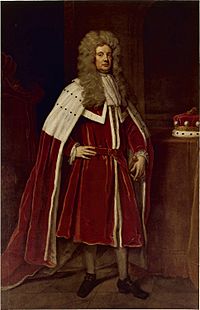
Cecil Calvert married Anne Arundell in 1627 or 1628. They had nine children, but only three of them lived to be adults, including their son Charles. Later, one of Maryland's first counties was named Anne Arundel County, Maryland in honor of Anne. Anne's father built a country house for her in 1637, which he gave to the couple in 1639.
Cecil, the 2nd Lord Baltimore, died in England on November 30, 1675. He was 70 years old. His son, Charles, took over as the next Baron Baltimore.
Death and Burial
He passed away in England on November 30, 1675. Records show he was buried at St. Giles-in-the-Fields Church in London, UK. However, the exact spot of his grave is not known.
In 1996, the Governor of Maryland placed a plaque at St. Giles's to remember Cecil Calvert.
Legacy and Honors
Maryland
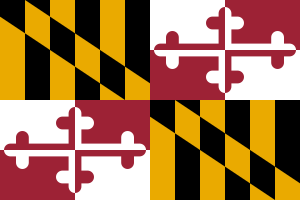
Many places in Maryland are named after the Barons Baltimore:
- Counties: Baltimore, Calvert, Cecil, Charles, and Frederick.
- Cities: City of Baltimore, Leonardtown, St. Leonard.
- Other places: Calvert Cliffs, Anne Arundel County.
Many streets also carry their names:
- Cecil Avenue
- Calvert Street
- Charles Street in Baltimore
- Baltimore Avenue in Ocean City, Maryland
- Baltimore–Washington Parkway
- Lord Baltimore Drive in Owings, Maryland
A statue of Cecil, Lord Baltimore, stands at the entrance of the Circuit Courthouse in Baltimore City. It is the site of yearly "Maryland Day" ceremonies on March 25.
The Flag of Maryland uses the colors and symbols from the Calvert family's coat of arms. The black and gold stripes are from the Calvert family, and the red and white cross is from his mother's family, the Crosslands. This flag first flew in 1880. During the American Civil War, different parts of the flag were used by soldiers from Maryland who fought on opposite sides. Later, using the full flag again helped bring the state together after the war. It officially became the State flag in 1904.
The Great Seal of Maryland also features the Calvert family's symbols and motto. This seal is still used by the Government of Maryland today.
Newfoundland
- The town of Calvert is on the Avalon Peninsula.
- Baltimore School is in nearby Ferryland.
Coat of Arms
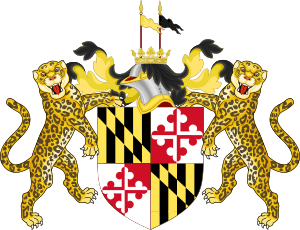
The black and gold parts of the shield were the Calvert family's own symbols. The red and silver parts were for the Crosslands, the family of the 1st Baron's mother.
- Shield: It has four sections. The first and fourth sections have six vertical bars in gold and black. The second and third sections have a cross with clover-like ends, in silver and red.
- Crest: Two flags flying out of a duke's crown, one gold and one black.
- Supporters: Two leopards standing guard.
- Motto: (Italian), Fatti maschii, parole femine, which means, "Manly deeds, womanly words."
The colors of the Calvert coat of arms inspired the name of the Baltimore oriole bird, which has orange and black feathers. The bird, in turn, inspired the name of the Baltimore Orioles baseball team.
See also
 In Spanish: Cecilius Calvert para niños
In Spanish: Cecilius Calvert para niños
- Baron Baltimore
- Colonial families of Maryland
- List of colonial governors of Maryland
- Province of Maryland
- Lord Baltimore penny


